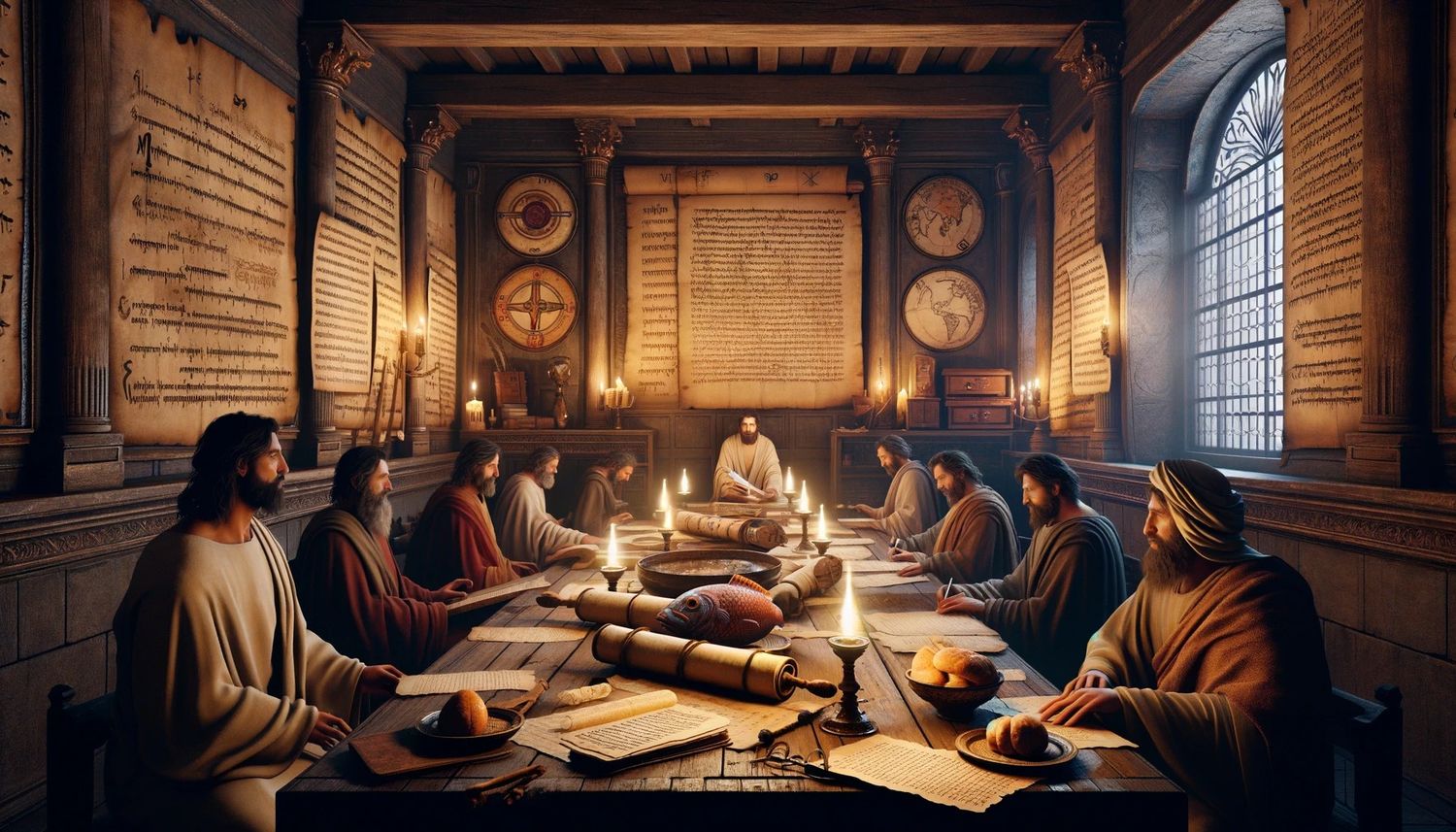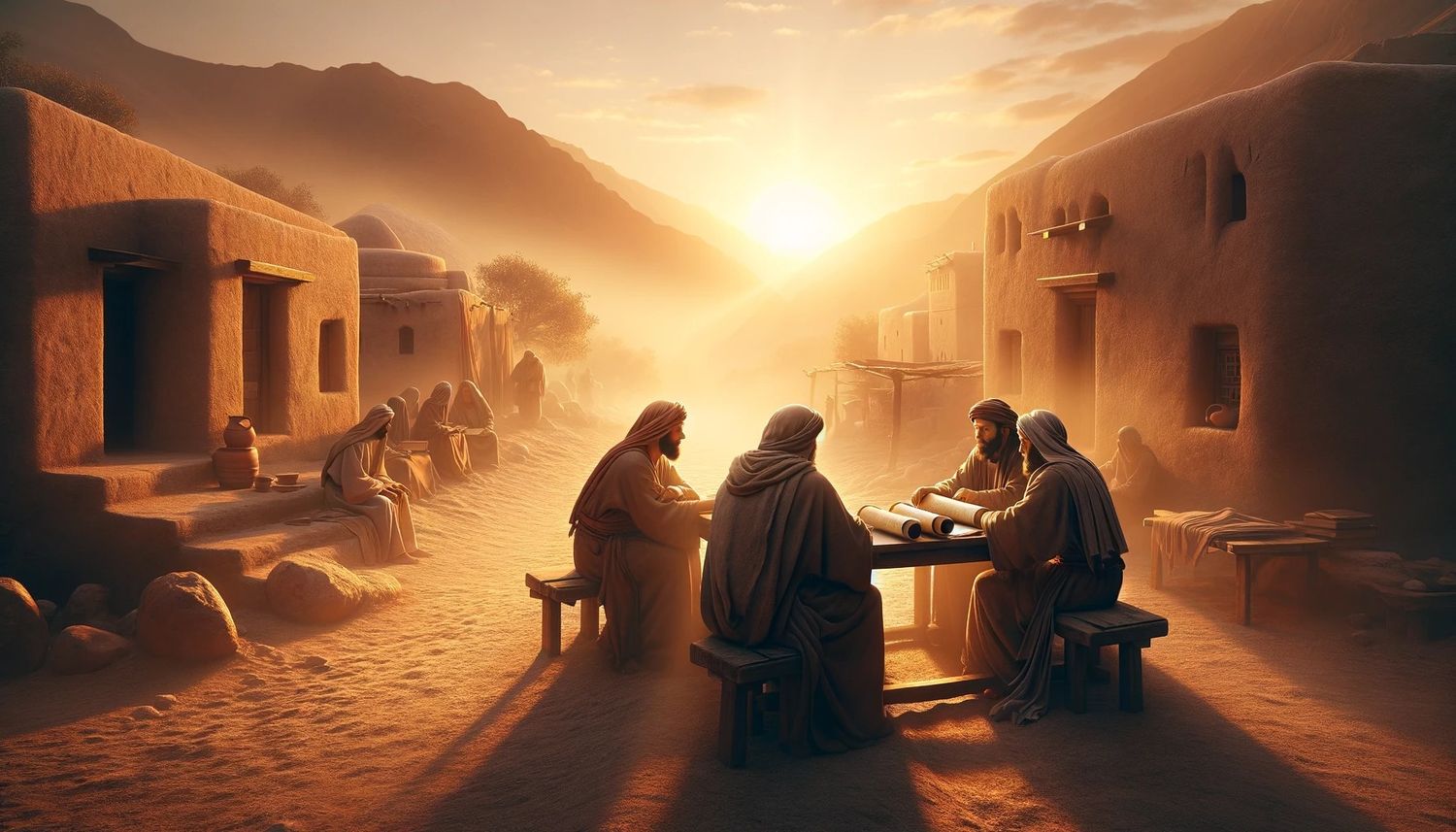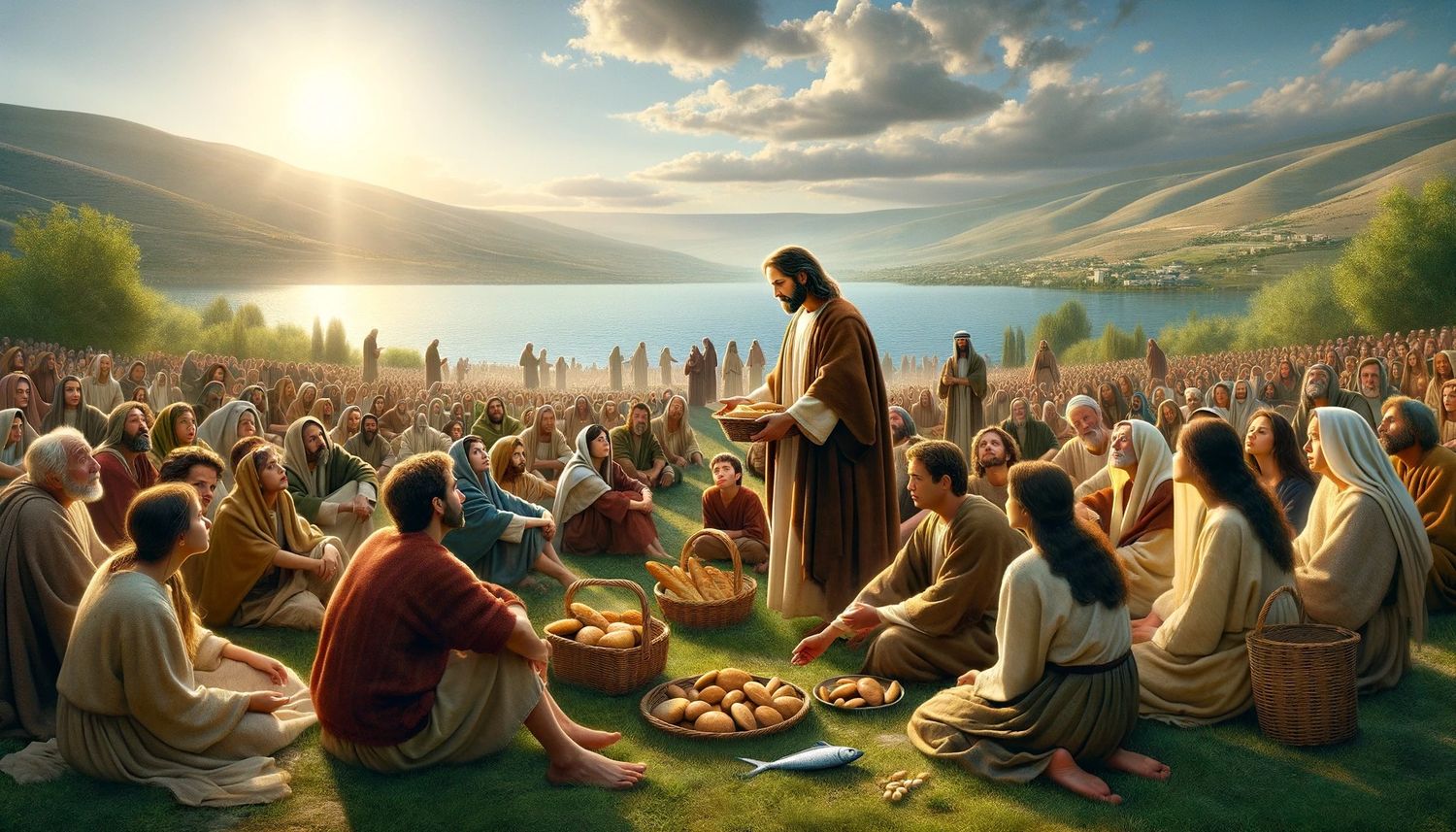Home>Christian Videos>Bible Stories>Why Scholars Doubt The Gospels


Bible Stories
Why Scholars Doubt The Gospels
Published: March 7, 2024
Ericka Andersen, an editor at Christian.net, expertly merges digital strategy with content creation, focusing on faith and societal issues. Her communication skills enhance the platform's engaging narratives, fostering meaningful dialogue on belief's impact on society.
Discover why scholars have doubts about the accuracy of Bible stories and the Gospels. Explore the historical and literary perspectives.
(Many of the links in this article redirect to a specific reviewed product. Your purchase of these products through affiliate links helps to generate commission for Christian.net, at no extra cost. Learn more)
Table of Contents
Introduction
Why do scholars doubt the Gospels? This is a question that has intrigued many individuals, both believers and skeptics, for centuries. The Gospels, which are the first four books of the New Testament, are considered by Christians to be the authoritative accounts of the life, teachings, death, and resurrection of Jesus Christ. However, there are scholars who cast doubt on the historical accuracy and reliability of these accounts. In this article, we will explore the reasons behind this skepticism and delve into the various factors that have led scholars to question the Gospels.
Read more: Why Four Gospels?
Historical Context of the Gospels
The Gospels were written in the first century CE, a time of great political and social upheaval in the Roman Empire. The Roman occupation of Judea, where the events of the Gospels are set, had a profound impact on the lives of the Jewish people. The region was characterized by religious fervor, messianic expectations, and resistance to Roman rule. It was within this volatile context that the Gospels emerged, seeking to convey the life and teachings of Jesus Christ. Understanding the historical backdrop is crucial in evaluating the Gospels' accounts, as it sheds light on the societal, cultural, and political dynamics that may have influenced the narratives.
-
The Roman Occupation: The pervasive presence of Roman authority and the imposition of Roman law and governance deeply affected the daily lives of the Jewish populace. This context of occupation and subjugation is integral to comprehending the environment in which the events of the Gospels unfolded.
-
Jewish Expectations: The Jewish people were anticipating the arrival of a messianic figure who would deliver them from oppression and establish a kingdom of God on earth. These messianic expectations permeated the religious and political landscape, shaping the aspirations and hopes of the Jewish community.
-
Religious Diversity: The region of Judea was characterized by a diverse religious landscape, with various sects and movements vying for influence and adherents. The presence of different religious perspectives and practices adds complexity to the historical context within which the Gospels were composed.
-
Oral Tradition: Prior to being transcribed, the accounts of Jesus' life and teachings were transmitted orally within the early Christian communities. This oral tradition played a significant role in shaping the narratives and may have introduced variations and interpretive elements into the Gospel accounts.
Understanding the historical milieu in which the Gospels emerged is essential for critically assessing their content and interpreting the events they depict. The complexities of the historical context provide a rich tapestry against which the Gospels must be examined, offering insights into the societal dynamics and religious fervor that characterized the era.
Authorship and Dating of the Gospels
The authorship and dating of the Gospels have been subjects of extensive scholarly inquiry and debate. Traditionally, the Gospels have been attributed to Matthew, Mark, Luke, and John, who were purported to be eyewitnesses or associates of eyewitnesses to the life of Jesus. However, modern scholarship has raised questions about these traditional attributions and the dates of composition.
-
Synoptic Problem: The Synoptic Gospels—Matthew, Mark, and Luke—exhibit significant literary and thematic similarities, giving rise to the "Synoptic Problem." This issue pertains to the interrelationships between these Gospels and the potential sources they may have utilized. The synoptic problem has led scholars to explore the possibility of literary dependence and the use of common sources, challenging traditional authorship attributions.
-
Markan Priority: Many scholars adhere to the theory of Markan priority, positing that the Gospel of Mark was the first to be written and served as a source for the authors of Matthew and Luke. This hypothesis has implications for the dating of the Gospels and raises questions about the direct eyewitness authorship of Matthew and Luke.
-
Dating of the Gospels: The dating of the Gospels is a contentious issue, with proposed dates ranging from the late 1st century to the early 2nd century. The dating of the Gospels has significant implications for their reliability as historical accounts, as earlier dates would support the possibility of eyewitness authorship, while later dates would suggest a greater reliance on oral tradition and written sources.
-
Authorship Attribution: The traditional ascriptions of authorship to the Gospels have been challenged on the basis of linguistic, literary, and theological considerations. The anonymity of the Gospels' authors within the texts themselves has prompted scholars to critically evaluate the evidence for direct eyewitness authorship and to consider the role of later communities in shaping the Gospel narratives.
The authorship and dating of the Gospels remain complex and contentious issues within biblical scholarship, with diverse perspectives and theories contributing to the ongoing discourse. These considerations are pivotal in assessing the historical reliability and interpretive significance of the Gospels, prompting scholars to engage in rigorous investigation and critical analysis of the textual, historical, and theological dimensions of these foundational Christian documents.
Discrepancies and Contradictions in the Gospels
The Gospels, despite their shared focus on the life and teachings of Jesus Christ, contain numerous instances of apparent discrepancies and contradictions. These variations in the Gospel accounts have been a subject of scholarly scrutiny and have contributed to the skepticism surrounding their historical reliability and coherence.
-
Chronological Variances: One of the prominent areas of divergence in the Gospels pertains to the chronology of events in Jesus' life. Differences in the sequencing of episodes, the timing of specific teachings and miracles, and the arrangement of narrative elements have been identified across the Gospel accounts. These chronological disparities have prompted scholars to investigate the potential reasons behind the variations and to assess their implications for historical accuracy.
-
Divergent Details: The Gospels present differing details and descriptions of significant events, such as the resurrection narratives, the genealogies of Jesus, and the circumstances surrounding key interactions. These divergences encompass elements of dialogue, the involvement of peripheral characters, and the specific locations and contexts of pivotal occurrences. The presence of divergent details has raised questions about the precise nature of the events and the reliability of the Gospel testimonies.
-
Theological Emphases: Each Gospel exhibits distinct theological emphases and interpretive lenses, shaping the portrayal of Jesus' identity, mission, and teachings. The theological perspectives of the Gospel authors have influenced the selection and presentation of material, leading to variations in the emphasis placed on certain events, discourses, and symbolic actions. These theological nuances contribute to the complexities of harmonizing the Gospel accounts and understanding their underlying purposes.
-
Narrative Harmonization: Efforts to reconcile the divergences and contradictions in the Gospels have given rise to the practice of narrative harmonization, wherein scholars and theologians seek to construct unified and seamless narratives by aligning the accounts of the different Gospels. The process of harmonization involves identifying complementary details, resolving apparent contradictions, and synthesizing the Gospel narratives into cohesive wholes. However, the pursuit of narrative harmonization raises questions about the integrity of the original accounts and the potential imposition of artificial harmonies.
The presence of discrepancies and contradictions in the Gospels underscores the complexities of interpreting and reconciling the diverse accounts of Jesus' life and ministry. These variations have prompted scholars to engage in rigorous textual analysis, source criticism, and hermeneutical reflection, seeking to discern the historical veracity and theological significance of the Gospel narratives.
Theological and Literary Motives in the Gospels
The Gospels, as foundational texts of the Christian faith, are imbued with theological and literary motives that shape their content, structure, and overarching messages. The authors of the Gospels were not merely chroniclers of historical events; they were individuals driven by theological convictions and literary objectives, seeking to convey specific theological themes and to present the life and teachings of Jesus Christ in a manner that aligned with their theological perspectives.
Read more: Why Are The Gospels Called The Gospels
Theological Motives
The Gospel writers were guided by profound theological motives that influenced their portrayal of Jesus and the theological messages they sought to communicate. These theological motives encompassed the divine nature of Jesus, the fulfillment of Old Testament prophecies, the establishment of the kingdom of God, and the salvific significance of Jesus' life, death, and resurrection. The theological underpinnings of the Gospels are evident in the selection of specific events, discourses, and miracles attributed to Jesus, as well as in the overarching narrative frameworks that underscore the theological import of his ministry.
Literary Motives
In addition to theological considerations, the Gospel authors were driven by literary motives that shaped the composition and presentation of their narratives. Each Gospel exhibits distinct literary features, narrative structures, and stylistic elements that reflect the author's literary intentions and the targeted audience. The literary motives encompassed the use of specific literary forms, such as parables, discourses, and narrative episodes, as well as the incorporation of symbolic and allegorical elements to convey theological truths. Furthermore, the Gospel authors employed literary devices to engage their readers, evoke emotional responses, and convey the significance of Jesus' teachings and actions within the narrative framework.
The intertwining of theological and literary motives in the Gospels underscores the multifaceted nature of these texts, highlighting their role as theological treatises and literary compositions. The fusion of theological depth and literary artistry within the Gospels contributes to their enduring impact and interpretive richness, inviting readers to engage with the profound theological truths and compelling narratives encapsulated within these foundational Christian documents.
External Sources and Corroboration of Gospel Accounts
The quest for external sources and corroboration of the Gospel accounts has been a focal point of scholarly investigation, as it seeks to situate the Gospels within the broader historical and cultural milieu of the ancient world. The examination of external sources and corroborative evidence serves to contextualize the events and figures depicted in the Gospels, providing insights into the historical plausibility and veracity of the Gospel narratives.
Jewish and Roman Historians
Scholars have scrutinized the writings of Jewish and Roman historians from the first century in search of references to Jesus, his followers, and the socio-political landscape of Judea. The works of historians such as Flavius Josephus, Tacitus, and Pliny the Younger have been subject to intense scrutiny, with scholars assessing the potential references to Jesus, early Christian communities, and the societal conditions that form the backdrop of the Gospel accounts. The examination of these external sources aims to discern the historical resonance of the Gospel narratives within the broader historical record of the ancient Mediterranean world.
Read more: Why Are The Gospels Important?
Archaeological Discoveries
Archaeological excavations and discoveries have provided valuable insights into the material culture, geographical settings, and societal dynamics depicted in the Gospels. The exploration of ancient sites, artifacts, and inscriptions has contributed to the contextualization of Gospel events and has shed light on the historical plausibility of the narratives. Archaeological findings have offered corroborative evidence for the existence of cities, structures, and customs mentioned in the Gospels, enriching our understanding of the historical backdrop against which the Gospel accounts unfold.
Non-Canonical Christian Writings
In addition to external secular sources, scholars have examined non-canonical Christian writings and apocryphal texts from the early Christian era. These texts, though not included in the New Testament canon, provide supplementary perspectives on the life of Jesus, the activities of his followers, and the theological currents within early Christianity. The comparison of non-canonical Christian writings with the canonical Gospels offers insights into the diversity of early Christian traditions and the multiplicity of perspectives on Jesus' life and teachings.
Corroborative Implications
The exploration of external sources and corroborative evidence holds implications for the historical reliability and interpretive significance of the Gospel accounts. The convergence of external testimonies, archaeological findings, and supplementary Christian writings can bolster the historical plausibility of the Gospel narratives, providing a broader framework for understanding the socio-historical contexts and the figures central to the Gospel events. However, the interpretive complexities and divergent scholarly perspectives underscore the ongoing nature of the quest for external corroboration and its implications for the understanding of the Gospels within the tapestry of ancient history and religious literature.
Conclusion: Implications of Doubt for Christian Faith
The implications of doubt regarding the Gospels reverberate throughout the landscape of Christian faith, prompting profound reflections on the nature of belief, the foundations of religious conviction, and the interpretive frameworks through which the Christian tradition is apprehended. The presence of scholarly skepticism and critical inquiry into the historical reliability of the Gospels engenders a dialectic between faith and historical inquiry, challenging believers to navigate the tensions between theological affirmations and historical scrutiny.
-
Faith and Historical Understanding: The doubt surrounding the Gospels necessitates a nuanced engagement with the interplay between faith commitments and historical understanding. Christian believers are confronted with the imperative to reconcile their theological convictions with the complexities of historical interpretation, fostering a dynamic dialogue between faith perspectives and historical methodologies.
-
Hermeneutical Reflection: The skepticism regarding the Gospels invites profound hermeneutical reflection within Christian communities, prompting individuals to grapple with the interpretive lenses through which the Gospels are approached. The exploration of doubt engenders a deeper awareness of the interpretive frameworks, theological presuppositions, and historical contexts that shape the reading and understanding of the Gospel narratives.
-
Theological Resilience: The presence of doubt serves as a catalyst for theological resilience within Christian faith, prompting believers to engage with the foundational tenets of their religious tradition and to articulate the enduring significance of the Gospel message amidst scholarly scrutiny. The encounter with doubt fosters a robust theological discourse, inviting believers to articulate the enduring relevance and transformative power of the Gospel narratives within the contemporary milieu.
-
Ecclesial Dialogue: The implications of doubt for the Gospels engender ecclesial dialogue and communal discernment within Christian congregations and denominational contexts. The exploration of scholarly skepticism invites collective reflections on the nature of biblical authority, the dynamics of faith and reason, and the communal interpretation of the Gospel narratives, fostering a shared engagement with the challenges and opportunities presented by historical inquiry.
-
Faith and Intellectual Inquiry: The presence of doubt within the scholarly discourse on the Gospels underscores the interface between faith commitments and intellectual inquiry, prompting believers to embrace the complexities of historical investigation while upholding the enduring truths and transformative power of the Gospel message. The encounter with doubt invites individuals to cultivate a robust intellectual engagement with the historical dimensions of the Gospels while affirming the enduring vitality of Christian faith.
In conclusion, the implications of doubt for the Gospels resonate deeply within the tapestry of Christian faith, inviting believers to navigate the intersections of faith, historical inquiry, theological reflection, and communal dialogue. The encounter with doubt fosters a dynamic engagement with the enduring significance of the Gospel narratives, prompting individuals and communities to articulate the transformative power of the Christian message amidst the complexities of historical interpretation.













